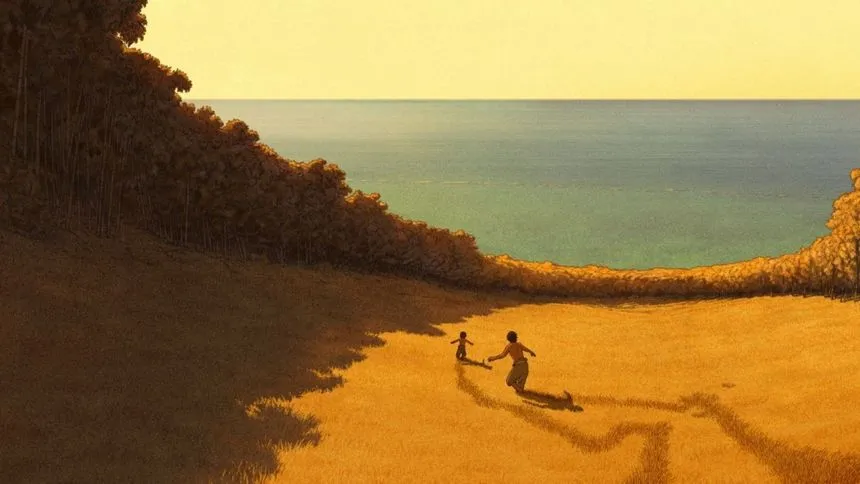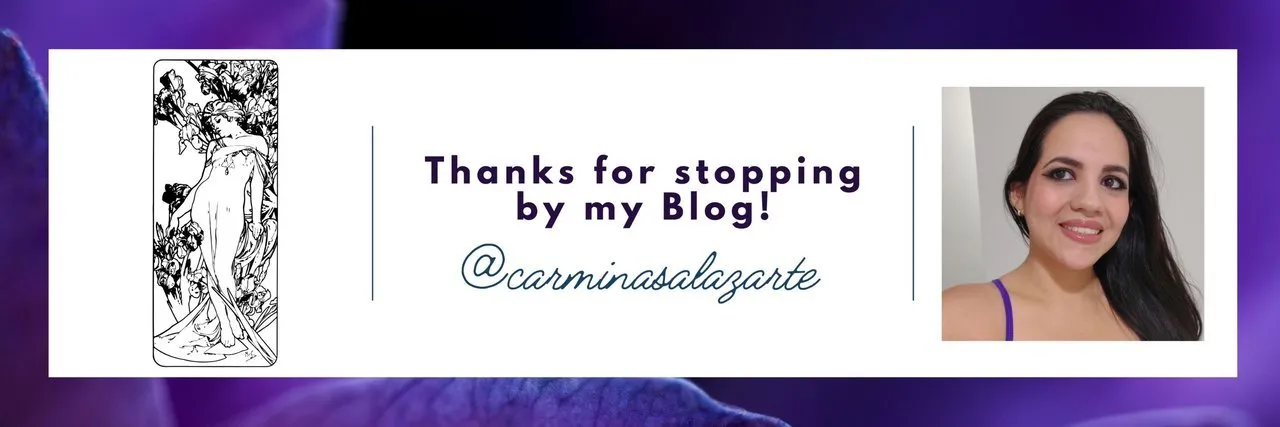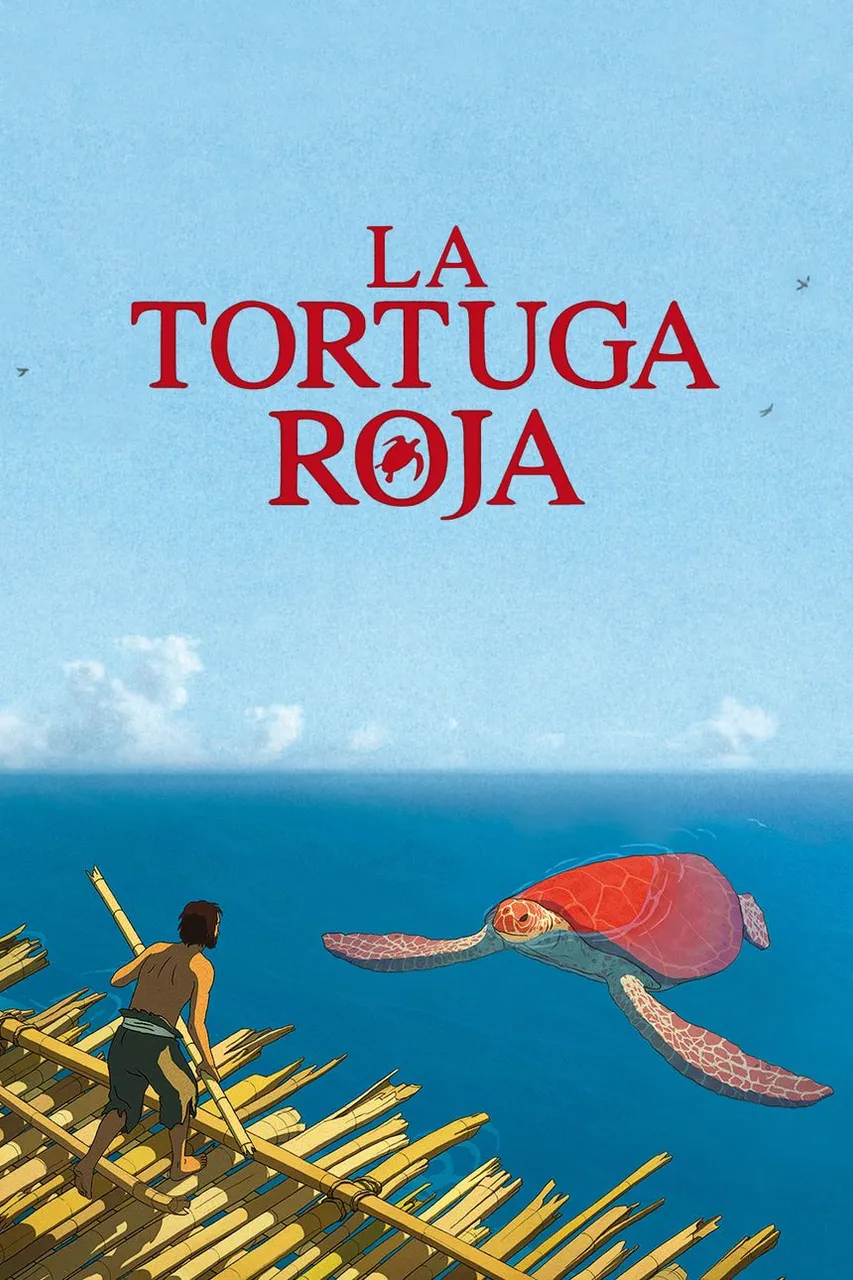
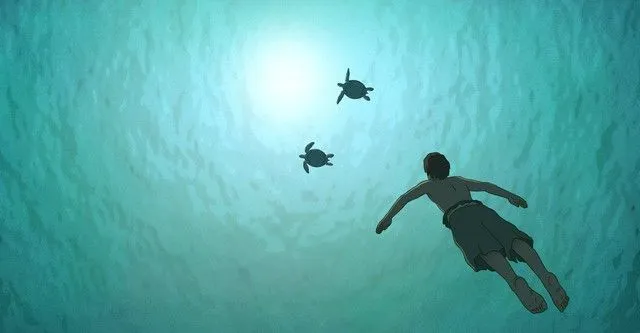
Greetings to everyone in The Real Anime community! Today I'm joining us with a new animated film review. This time, it's not a purely Japanese animated film, but a collaboration between France, Belgium, and, of course, Japan. It's The Red Turtle, from director Michael Dudok de Wit, with producers Wild Bunch and Studio Ghibli. Released in 2016, the film premiered at the Cannes Film Festival, where it was well-received by critics. A moving, innovative animation offering of high quality, as expected from such production houses. If you're a fan of animated films that deal with themes of environmental awareness, human nature, redemption, and spiritual well-being as a goal to be achieved, you'll love The Red Turtle. Here's what I'll tell you all about it.
The story centers on a man who gets caught in a storm at sea and ends up on an island. On this island, there are great blessings: fruit trees, fresh water, animals everywhere, and everything necessary for survival. However, the man has a strong desire to leave at all costs. That's why he decides to create a raft with the intention of going out to sea. Once he has the raft ready, he begins his journey, but unfortunately for him, a mysterious creature destroys (almost intentionally) his raft. The man repairs his raft again and returns to the sea, but the creature attacks again. This is how he later visualizes the culprit of the incident: an enormous red turtle. He returns to the shore frustrated, and that's when the turtle tries to get there too, but the man, upset that it destroyed his raft, decides to turn it over in revenge, leaving it to its fate, and leave it to its fate. Regretting his decision, he returns to where the turtle was but realizes that it has died. With the arrival of rain, one day the man returns to the place where the deceased turtle was and finds a red-haired woman. From then on, things will turn out differently for the man.
¡Saludos a todos en la comunidad de The Real Anime! El día de hoy me uno por aquí para traer una nueva reseña de película animada. En esta oportunidad, no es una película animada netamente japonesa sino una colaboración entre Francia, Bélgica y por supuesto, Japón. Se trata de La Tortuga Roja, del director "Michaël Dudok de Wit", con las productoras "Wild Bunch" y "Studio Ghibli". Siendo del año 2016, la película fue estrenada en el Festival de Cannes, dónde tuvo un buen recibimiento por parte de la crítica; una propuesta conmovedora, innovadora en cuanto animación y de gran calidad según lo que podría esperarse de tales nombres. Si eres un fanático de las películas animadas dónde se tratan temas sobre consciencia ambiental, la naturaleza humana, la redención y el bienestar espiritual cómo un fin a alcanzar, La Tortuga Roja te va a encantar. Aqui les cuento todo al respecto.
La historia se centra en un hombre que queda atrapado en una tormenta en el mar y termina parando en una isla. En dicha isla hay grandes bondades; árboles frutales, agua dulce, animales por doquier y todo lo necesario para sobrevivir. Sin embargo, el hombre tiene un fuerte deseo por salir de allí a toda costa. Es por eso que decide crear una balsa con la intención de ir mar adentro. Una vez que tiene lista la balsa emprende su viaje, pero para su mala suerte, una criatura misteriosa destruye (casi adrede) su balsa. El hombre nuevamente repara su balsa y vuelve al mar, pero la criatura vuelve a atacar. Es así cómo luego visualiza a la culpable del asunto: una enorme tortuga roja. Regresa a la orilla frustrado y es cuando la tortuga intenta llegar también allí, pero el hombre molesto porque ella acabó con su balsa, decide voltearla en venganza y dejarla a su suerte e irse. Arrepentido por esta decisión, vuelve a dónde estaba la tortuga pero se da cuenta que ha muerto. Con la llegada de la lluvia, un buen día el hombre vuelve al lugar dónde estaba la fallecida tortuga y encuentra a una mujer de cabello rojo. De alli en más, las cosas se tornarán diferentes para el hombre.
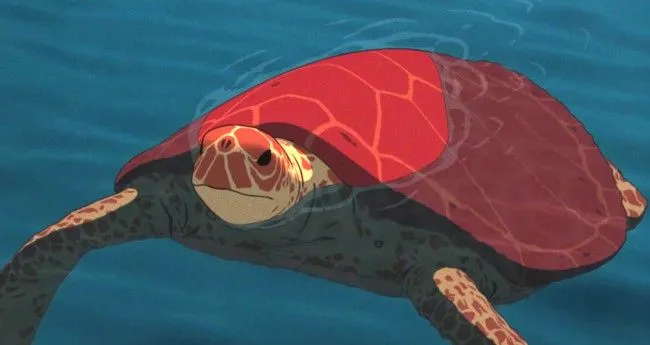
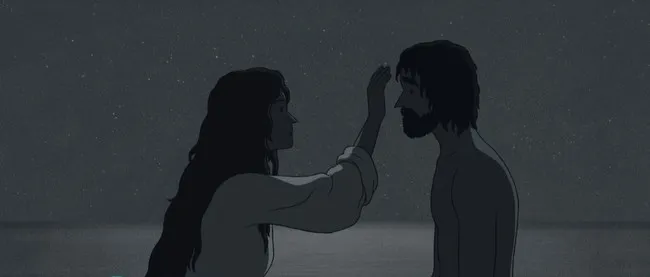
The film unfolds silently; there is no dialogue, not a single word. Therefore, everything is left to the direction of images and sounds, a language that helps communicate the message to the viewer. This is extremely appealing because it's unusual to find films of this genre without dialogue, but that (from my perspective) is pleasing and ideal, given the setting. In any case, it lends itself to the context of the film, where the man truly cannot communicate with the turtle through words, and even if he did, it wouldn't be a significant contribution (something that would make a difference). I prefer it this way, without a single word. They say that a picture is worth a thousand words. Furthermore, the film is based on that.
The film is haunting because it touches on several sensitive issues. The turtle represents nature, presented as a creator of possibilities, opportunities, and many good things. Hence her metamorphosis from turtle to woman. Human behavior is a reflection of the decadence we can subject others to, but which can eventually be transformed (in other ways) thanks to the acceptance of that goodness and well-being that can only be achieved when one recognizes oneself as part of a whole. In other words, for me, the film speaks of a struggle between man and his own nature, and when he finally accepts it (not chasing it, fleeing from it, or mistreating it), he becomes one with it. The stages of life—its origin and end—are also discussed here. Without going any further, I think everyone should watch it and draw their own conclusions. It's a truly beautiful film and is suitable for all ages. Without further ado, thank you so much for stopping by.
La película transcurre de forma silente; no hay diálogos, ni palabra alguna. Por lo cual todo queda en manos de la dirección de las imágenes y sonidos, lenguaje que ayuda a comunicar el mensaje al espectador. Eso es algo sumamente atractivo pues es inusual encontrar películas de este género donde no existan los diálogos, pero eso (según mi perspectiva) resulta agradable e ideal según el escenario. En todo caso, se presta al contexto de la película, dónde el hombre realmente no puede comunicarse con palabras con la tortuga y aunque lo hiciera, no sería un aporte significativo (algo que hiciera la diferencia). La prefiero así, sin ni una sola palabra. Ya dirían por allí que una imagen vale mal que mil palabras. Además, la película se fundamento en ello.
La película resulta sobrecogedora pues toca varias cuestiones sensibles. La tortuga representa a la naturaleza, siendo esta presentada cómo una creadora de posibilidades, oportunidades y muchas bondades. De allí su metamorfosis de tortuga a mujer. El comportamiento del hombre siendo un reflejo de la propia decadencia a la que podemos someter a los demas, pero que eventualmente puede transformarse (de otras formas) gracias a la aceptación de esa bondad y bienestar que solo puede alcanzarse cuando uno se sabe dentro de la parte de un todo. Es decir, para mí la película habla sobre una lucha del hombre contra su propia naturaleza y cuando finalmente la acepta (no la persigue, no huye, no la maltrata) se vuelve una sola con ella. Las etapas de la vida; el origen y el final de la misma, también se plantean aquí. Sin ir más allá, creo que cada quién debe verla y sacar sus propias conclusiones. Es una película realmente bella y es apta para todas las edades. Sin más que decir, muchísimas gracias por pasar por aquí.

